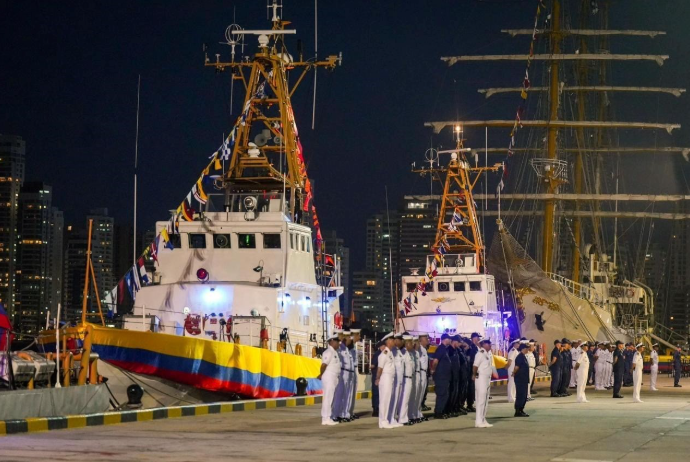Aug. 5, 2025 —

Former Coast Guard Cutters Liberty, Mustang and Naushon are transferred to Colombia on June 14, 2025. Training on operation and maintenance of the 110-foot Island-class patrol boats was completed June 27. U.S. Coast Guard photo.
The Coast Guard Office of International Acquisition has delivered more than $1 billion in assets and services to partner nations in support of national security objectives through its Foreign Military Sales (FMS) and Excess Defense Articles (EDA) programs. The total represents more than 700 vessels, aircraft and related support delivered to more than 80 countries since the Coast Guard office was reorganized in 1997.
One of the most recent deliveries is the EDA transfer of three decommissioned 110-foot Island-class patrol boats to Colombia. Former Coast Guard Cutters Liberty, Mustang and Naushon were transferred on June 14. The Coast Guard also conducted training with Colombian Navy crews on how to operate and maintain the vessels.
The United States and Colombia have a shared commitment to combat illicit maritime activity, with an emphasis on countering narcotics trafficking. The vessels, which were replaced in the Coast Guard fleet with the increased capability of the fast response cutters, will be used in Colombia for missions such as coastal surveillance, maritime interdiction and counter-narcotics. The Coast Guard has transferred additional 110-foot patrol boats to Costa Rica, Georgia, Greece, Pakistan, Tunisia and Ukraine. A transfer of two patrol boats to Ecuador is currently underway.
Under the FMS program, foreign partner nations procure new assets, spare parts, training and technical assistance through the Coast Guard. Under the EDA program, decommissioned Coast Guard assets are transferred to foreign partners as $0 grants. EDA transfers also have an FMS component because the foreign partner receiving the asset pays to bring it to operational status and for training and any enhancements they may want added.
Both programs are valuable tools in a larger security cooperation program that enables the Coast Guard to make significant contributions to building and sustaining global maritime partnerships in support of U.S. maritime strategy. For example, decommissioned 87-foot patrol boats transferred to Uruguay in 2022 help that country safeguard lawful trade and travel, counter drug trafficking and prevent vessels suspected of illegal, unregulated and unreported fishing from using the area as a safe haven.
The Coast Guard Office of International Acquisition currently has more than 130 active EDA and FMS cases in progress with 64 countries. In some cases, deliveries have been made to multiple services within the same partner nation; for example, Bangladesh has active cases for boats and related support for their coast guard, army and navy. And more than half of first-time customers have established subsequent cases.
The Coast Guard recently completed transfer of the largest vessel class to be part of the EDA program, the 378-foot high endurance cutter, when former Coast Guard Cutter Mellon arrived in Vietnam on June 18. Replaced by the national security cutter fleet, a total of 12 high endurance cutters were transferred to Bangladesh, Nigeria, Sri Lanka, Vietnam and the Philippines.
Larger cutters like the high endurance cutter highlight another benefit of the EDA program: for every decommissioned vessel that can be transferred to a foreign partner, the Coast Guard avoids paying for extended storage, risk mitigation and potential scrapping of the vessel. For the 12 high endurance cutters, that translates into a cost avoidance of around $41 million. While disposal cost savings for many of the vessels have not been tracked, estimated savings to date are at least $150 million.
The majority of new procurements are boats, ranging from 4.7-meter inflatables to 33-foot special purpose craft-law enforcement boats, from 20-foot rigid hull inflatable boats and 7-meter over the horizon cutter boats to 45-foot response boats. Anticipated deliveries in the coming year include a 12-meter patrol boat to Antigua and Barbuda, three 38-foot ambulance boats to Barbados, six 25-foot riverine craft boats and five 21-foot center console boats to Colombia, two 41-foot interceptor boats to Costa Rica, 20 4.7-meter inflatable boats to Guatemala, eight 45-foot response boats to Lebanon and two 65-foot patrol boats to Tunisia. Other procurements are for communications systems for the EDA vessels, training, Search and Rescue Optimal Planning System equipment, spare parts and even a few aircraft.
One area that continues to grow is Building Partner Capacity (BPC) programs; the number of cases has almost tripled in the past 10 years. BPC is a special type of FMS case, in which the activities are funded by U.S. government appropriations for the purpose of building partner security force capability through a process that is much faster than the standard FMS process. Examples of anticipated BPC deliveries in the next year include four 24-foot riverine boats to Senegal, 10 25-foot riverine interceptor boats to Paraguay, 16 4.7-meter inflatable boats to Panama, 12 inflatables to Jordan, four 38-foot full cabin response boats to Ghana and two 4.7-meter inflatables to El Salvador.
The Coast Guard Office of International Acquisition has been offering follow-on support as another line of effort for the last two years. This works to ensure the partner nation has the spare parts, equipment, technical assistance and training needed to sustain their assets for an extended period.
For more information: International Acquisition Program page